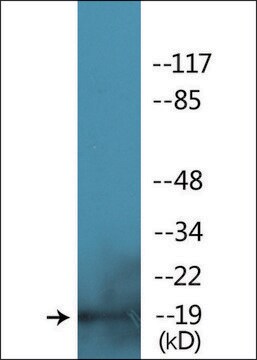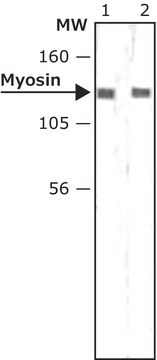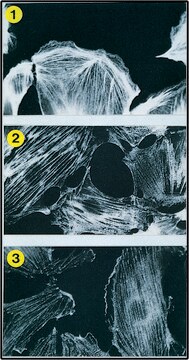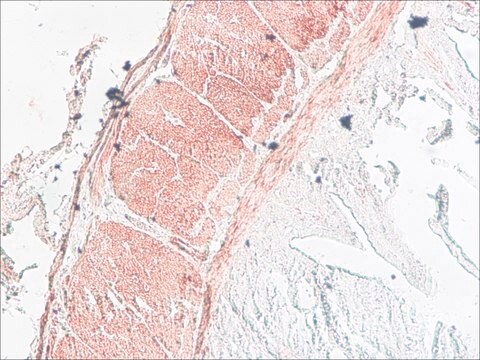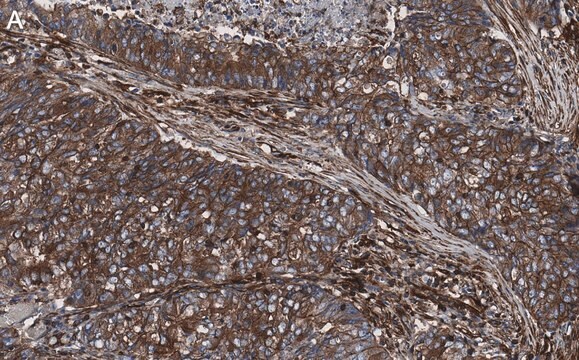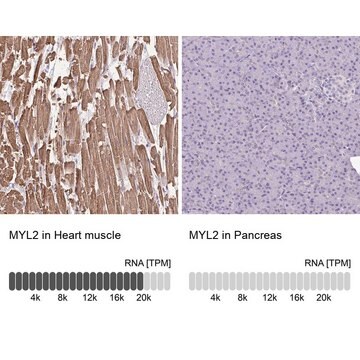M6068
Anti-phospho-Myosin Light Chain (pSer19) antibody produced in rabbit
affinity isolated antibody, buffered aqueous glycerol solution
Synonym(s):
Anti-MLC
Sign Into View Organizational & Contract Pricing
All Photos(1)
About This Item
Recommended Products
biological source
rabbit
Quality Level
conjugate
unconjugated
antibody form
affinity isolated antibody
antibody product type
primary antibodies
clone
polyclonal
form
buffered aqueous glycerol solution
species reactivity
human (predicted), chicken
technique(s)
western blot: 1:1,000 using chicken gizzard myosin II phosphorylated in vitro by PAK
shipped in
dry ice
storage temp.
−20°C
target post-translational modification
phosphorylation (pSer19)
Gene Information
human ... MYL1(4632)
Related Categories
General description
Myosin light chains belongs to the calmodulin (CaM) gene family.
Rabbit polyclonal anti-phospho-Myosin Light Chain (pSer19) antibody detects chicken MLC. Results show that reactivity with the antibody requires phosphorylation of MLC by active kinase, and that only the peptide corresponding to MLC (pSer19) blocks the antibody signal, thereby demonstrating the specificity of the antibody. Human (100% homologous) has not been tested, but is expected to react.
Immunogen
synthetic phosphopeptide derived from the region of chicken MLC that contains serine 19 (serine 20 including the initiating methionine). Human (100% homologous) has not been tested, but is expected to cross-react.
Application
Anti-phospho-Myosin Light Chain (pSer19) antibody produced in rabbit has been used in the detection of phosphorylated myosin: in human lung fibroblasts and avian lens cells by immunoblotting by immunohistochemical detection in rabbit aorta samplesby immunofluorescence detection in human submandibular gland tissues
Biochem/physiol Actions
Myosin light chain is a subunit of the conventional myosins, e.g., myosin II. In smooth muscle and nonmuscle cells, conventional myosins mediate a wide variety of contractile events including cytokinesis, cell motility, and smooth muscle contraction. MLC is phosphorylated by multiple serine-threonine kinases such as Rho-kinase and PAK, however, myosin light chain kinase (MLCK) acts as the primary kinase. Contractile activity of conventional myosins is regulated by phosphorylation of MLC on several residues. Phosphorylation of serine 19, the major phosphorylation site and the preferred site for MLCK, activates myosin motor activity under physiological conditions.
Myosin light chains functions to maintain integrity of myosin protein. Mutations in the myosin light chain is implicated in familial hypertrophic cardiomyopathy.
Physical form
Solution in Dulbecco′s phosphate buffered saline (without Mg2+ and Ca2+), pH 7.3 (± 0.1), 50% glycerol with 1.0 mg/mL BSA (IgG and protease free) and 0.05% sodium azide.
Disclaimer
Unless otherwise stated in our catalog or other company documentation accompanying the product(s), our products are intended for research use only and are not to be used for any other purpose, which includes but is not limited to, unauthorized commercial uses, in vitro diagnostic uses, ex vivo or in vivo therapeutic uses or any type of consumption or application to humans or animals.
Not finding the right product?
Try our Product Selector Tool.
Storage Class Code
10 - Combustible liquids
WGK
WGK 1
Flash Point(F)
Not applicable
Flash Point(C)
Not applicable
Choose from one of the most recent versions:
Already Own This Product?
Find documentation for the products that you have recently purchased in the Document Library.
Shuichi Asano et al.
Physiological reports, 5(9) (2017-05-17)
In patients with pulmonary diseases such as idiopathic pulmonary fibrosis and severe acute respiratory distress syndrome, progressive pulmonary fibrosis is caused by dysregulated wound healing via activation of fibroblasts after lung inflammation or severe damage. Migration of fibroblasts toward the
Sara Luck et al.
Molecular vision, 17, 2759-2764 (2011-11-09)
While many studies investigate the cytoskeletal properties of the lens with respect to cataract development, examinations of how these molecular structures interact are few. Myosin light chain kinase (MLCK), actin, and myosin are present on the crystalline lenses of chickens.
The effects of actomyosin disruptors on the mechanical integrity of the avian crystalline lens
Won GJ et al.
Molecular Vision, 21(9), 98-98 (2015)
Myosin light chain kinase inhibitor ML7 improves vascular endothelial dysfunction via tight junction regulation in a rabbit model of atherosclerosis
Cheng X, et al.
Molecular Medicine Reports, 12(3), 4109-4116 (2015)
Myosin light chains: teaching old dogs new tricks
Heissler SM and Sellers JR
Bioarchitecture, 4(6), 169-188 (2014)
Our team of scientists has experience in all areas of research including Life Science, Material Science, Chemical Synthesis, Chromatography, Analytical and many others.
Contact Technical Service